A few years back, I wrote a piece about the increasing popularity of combining STEM and arts subjects during Key Stage 5, with the pun-tastic title ‘The rise of STEAM’. I’m not sure that gag got the recognition it deserved at the time, so I thought I’d give it another go with this follow up.
Apart from the excellent pun opportunities, this topic fits in with one of our prevailing interests on this blog: subject choice at Key Stage 5. More specifically, here we’ll be looking at subject combinations.
The concept of STEAM – integrating science and the arts – has arguably become fairly mainstream in recent years. But do pupils actually choose to combine these subjects when they are given the choice? And are STEAM combinations still on the rise?
We’ll look at trends over the last five years, and also the three years before the pandemic. In other words, we’ll be looking at qualifications that were completed from 2017-24.
Data
We’ll be using data from the KS4 and KS5 pupil and exam tables from the National Pupil Database. We will include all students who completed Key Stage 5 in 2017-24.
For the purposes of this post, we grouped the following mapping codes into subjects:
- Art & Design
- Art & Design, Art & Design (3d Studies), Art & Design (Critical Studies), Art & Design (Fine Art), Art & Design (Graphics), Art & Design (Photography), Art & Design (Textiles))
- Design and technology (D&T)
- D&T Engineering, D&T Product Design, D&T Textiles Technology, D&T Systems & Control, D&T Food Technology
- Media / Film / TV studies
- Film Studies, Media/Film/TV Studies),
- Performing/Expressive arts
- Drama & Theatre Studies, Dance, Expressive Arts & Performance Studies
Entries in STEM and the arts
We’ll focus today on A-Levels, which lend themselves more to STEAM combinations than most technical and vocational qualifications: T-Levels, in particular, are not really intended to be taken along with another qualification.
Let’s start by looking at how entries to individual arts and STEM subjects have changed since 2017.
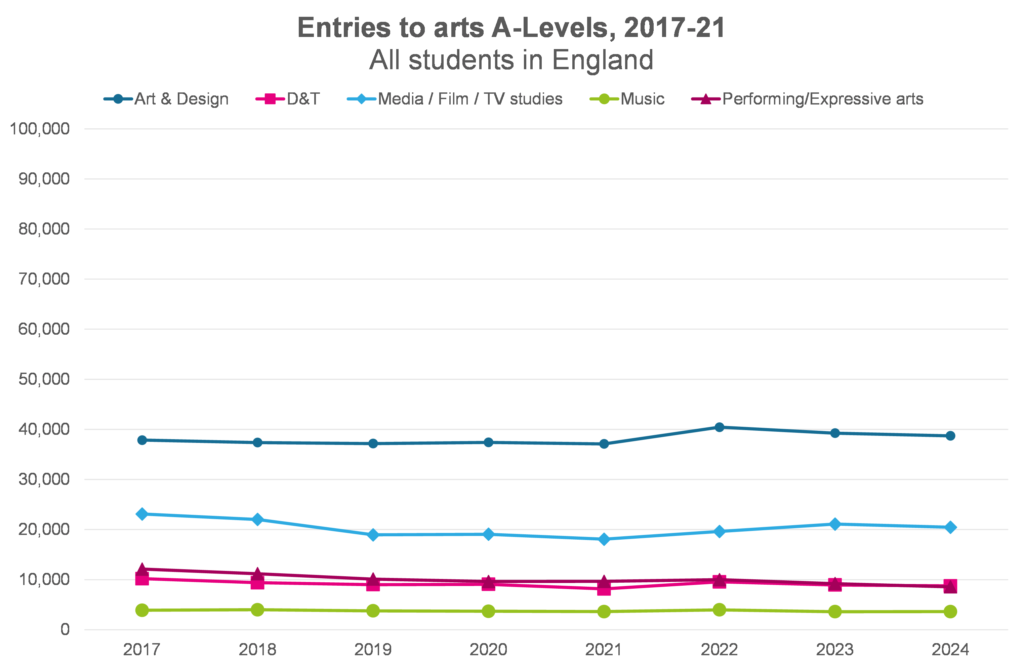

Sign up to our newsletter
If you enjoy our content, why not sign up now to get notified when we publish a new post, or to receive our half termly newsletter?
Biology, chemistry and maths all consistently had more entries than any individual arts subject. Every STEM subject had more entries in 2024 than in 2017, while every arts subject – bar art and design – had fewer.
So, on the whole, it’s probably fair to say that STEM subjects are more popular than arts subjects at A-Level, and that STEM subjects have become more popular over recent years, while most arts subjects have become less so.
Subject combinations
Now let’s see which STEAM combinations students are choosing.
The chart below shows the ten most popular STEAM options last year. We’ve included combinations of three or more A-Levels.
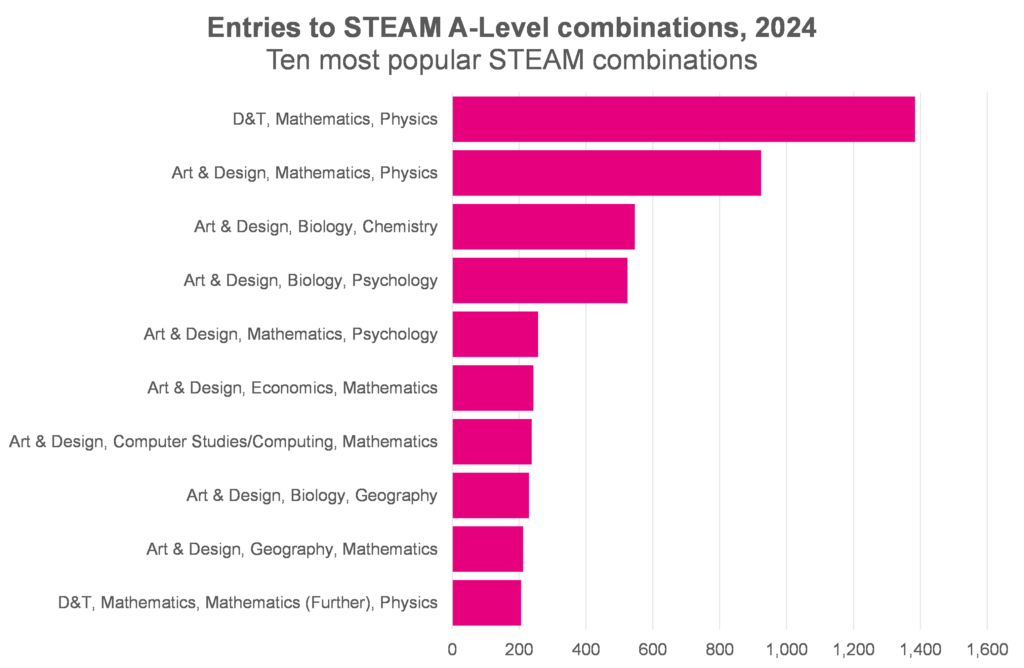 The top two combinations – D&T, maths and physics, and art & design, maths and physics – have been the two most popular options every year since 2017. Combinations of art, biology and chemistry, and art, biology and psychology have been consistently popular.
The top two combinations – D&T, maths and physics, and art & design, maths and physics – have been the two most popular options every year since 2017. Combinations of art, biology and chemistry, and art, biology and psychology have been consistently popular.
Some combinations that have become more common in recent years are art & design, computer science and maths, and art & design, maths and psychology.
We should note, though, that entries to STEAM combinations are relatively low. Just 1,384 students entered the most popular STEAM combination last year. To put that into context, 15,211 entered the most popular A-Level combination, which was biology, chemistry and maths.
The rise of STEAM
Let’s bring out that pun one more time as we look at whether entries to STEAM subject combinations have increased since 2017.
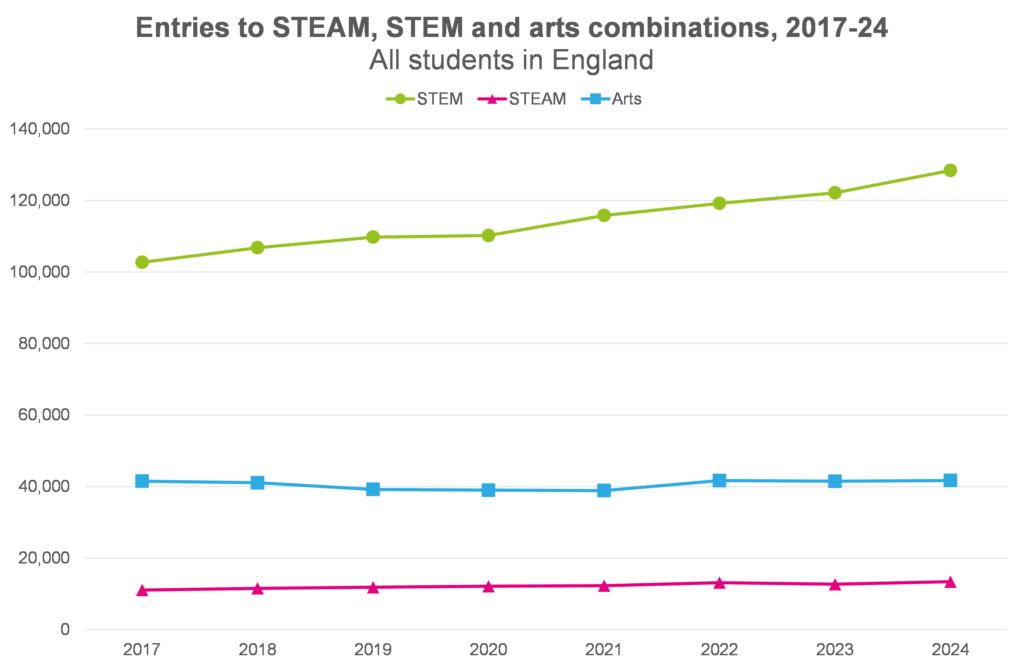 It doesn’t look very dramatic on this chart, certainly not compared to the increase in entries to combinations involving STEM, but there has been an increase in entries to STEAM combinations.
It doesn’t look very dramatic on this chart, certainly not compared to the increase in entries to combinations involving STEM, but there has been an increase in entries to STEAM combinations.
This does coincide with an increase in entries to any combination of three or more A-Level, but it is a sharper increase. Entries to any combination are up 12% since 2017, while entries to STEAM combinations are up 21%, to STEM 24% and to the arts less than 1%.
Finally, we can look at the demographics of the students studying a STEAM combination of A-Levels. Note that data on disadvantage – measured here based on whether students were eligible for free school meals in the six years before they completed KS4 – is only available for those who completed KS4 in a state-funded school. We therefore exclude those who did not do so from the relevant bar in the chart below.
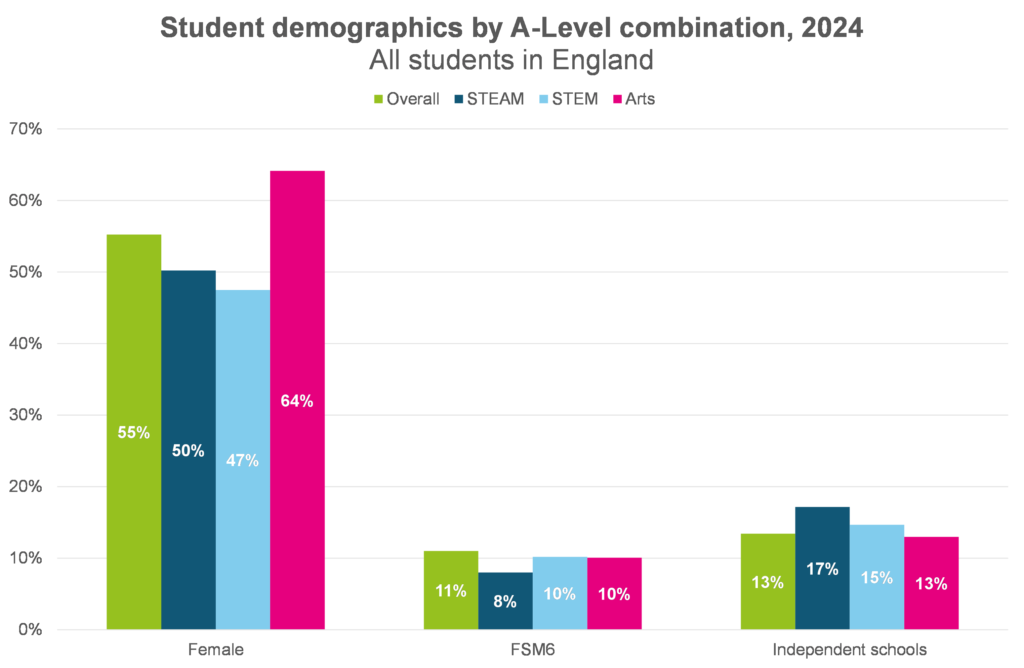 The patterns here are very similar to when we last looked at STEAM in 2022. STEAM students include a lower proportion of female students than all A-Level students and arts students, but a higher proportion than STEM students.
The patterns here are very similar to when we last looked at STEAM in 2022. STEAM students include a lower proportion of female students than all A-Level students and arts students, but a higher proportion than STEM students.
STEM and arts students who completed KS4 in state-funded schools were slightly less likely to be disadvantaged than all A-Level students who completed KS4 in state-funded schools. And STEAM students were even less likely. They were also more likely to have attended an independent school.
Summing up
The popularity of STEAM combinations does appear to be increasing. As we noted in our last piece on this topic, the rise in STEAM A-Level entries has coincided with an increase in entries to STEM A-Levels. So it may be the case that as STEM entries have increased, they have come to include a broader range of students, including more who are interested in both STEM and the arts.
But it is worth noting that STEAM combinations are somewhat less popular among more disadvantaged students.
Want to stay up-to-date with the latest research from FFT Education Datalab? Sign up to Datalab’s mailing list to get notifications about new blogposts, or to receive the team’s half-termly newsletter.




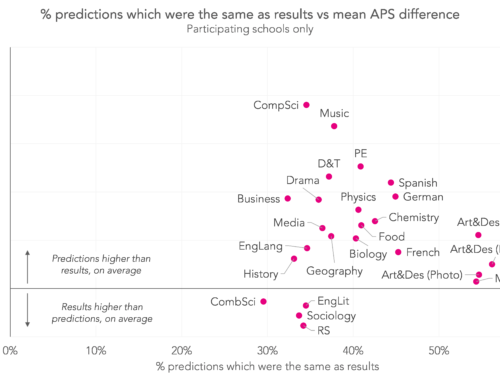

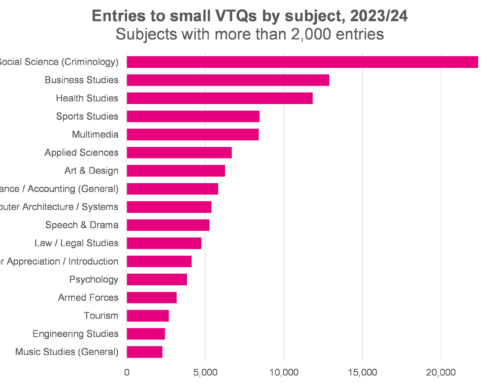
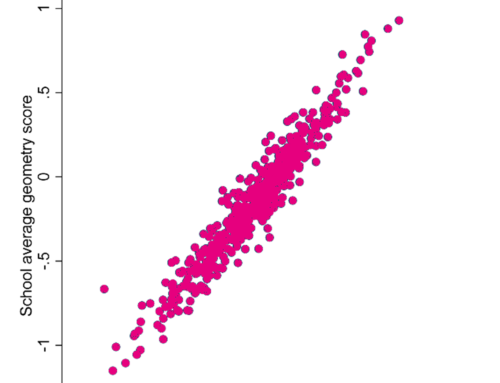
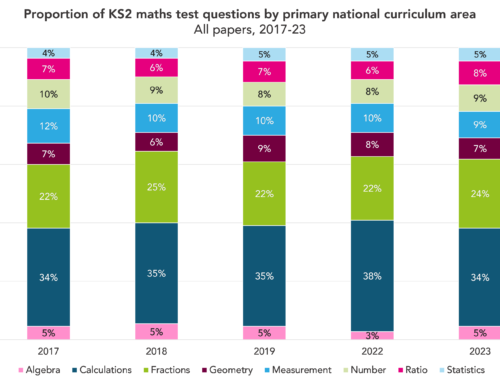
Thank you for de-mist-ifying the complex STEAM world!